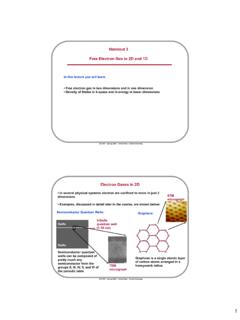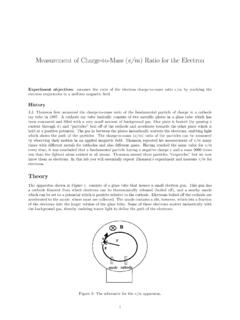Transcription of Electrolysis of dilute sulfuric acid - Physics
1 Electrolysis of dilute sulfuric acidThe products of electrolysing water acidified with sulfuric acid are hydrogen gas and oxygen gasTwo experimental setups are described, the Hofmann voltameter demonstration (left diagram) and a simple cell (right diagram) for use in schools and colleges for pupils to use. dilute sulfuric acid is used as the electrolyte in this investigation. The Hofmann voltameter is filled with the electrolyte (sulphuric acid ) by opening the taps at the top of the outer tubes to allow any gas to escape. The gases formed on the Electrolysis of the dilute sulfuric acid can be collected via the same taps. The platinum or carbon electrodes are need inert (non reactive) electrodes like platinum (left) and much cheaper carbon (graphite, right). In the simple Electrolysis cell, the graphite (carbon) electrodes are, through a large rubber bung, 'upwardly' dipped into an solution of acidified water.
2 In this cheap and simple apparatus the gaseous products (hydrogen and oxygen) are collected in small test tubes inverted over the carbon electrodes. You have to fill the little test tubes with the electrolyte (dil. sulfuric acid ), hold the liquid in with your finger and carefully invert them over the nearly full Electrolysis cell. The gases can be collected and should note that the Electrolysis will only take place when electricity is passed through the dilute sulfuric acid gasses can be collected with a small plastic test tube and ignited with a lit splint, giving a satisfying electrolyte is dilute sulphuric acid (= acidified water) which, during Electrolysis is split into hydrogen and oxygen gases. Theoretically into a 2 : 1 ratio by gas is one experimental method of showing water is a compound composed of the elements hydrogen and oxygen atoms by splitting liquid water into two gaseous element molecules of hydrogen (H2) and oxygen (O2).
3 Water only ionises to a tiny extent giving minute concentrations of hydrogen ions and hydroxide ions, so the presence of high concentrations of hydrogen ions (H+ or H3O+) and sulfate ions (SO42 ) from the acid , makes water a much better electrical conductor (a much better electrolyte solution). These small extra ion concentrations of hydrogen ions (H+) and hydroxide ions (OH ) are from the self-ionisation of water electrode reactions and products of the Electrolysis of acidified water are illustrated by the theory diagram aboveThe half-equations for the Electrolysis of water (electrolyte of acidified with dilute sulphuric acid ). (a) The negative cathode electrode reaction for the Electrolysis of waterThe negative cathode electrode reaction is a reduction ( electron gain).The hydrogen ions (H+) are attracted to the negative cathode and are discharged as hydrogen hydrogen ion or water molecules are reduced to hydrogen gas molecules by electron gain at the negative electrode2H+(aq) + 2e ==> H2(g) (hydrogen gas, bubbles seen on the negative electrode)positive ion reduction by electron gainor 2H3O+(aq) + 2e ==> H2(g) + 2H2O(l)All three equations amount to the same overall change the formation of hydrogen gas molecules and as far as I know any is acceptable in an exam?
4 The Electrolysis of many salts (of reactive metals) or acid solutions produce hydrogen at the negative cathode electrode. All acids give hydrogen at the cathode. (b) The positive anode electrode reaction for the Electrolysis of waterThe positive anode reaction is an oxidation electrode reaction ( electron loss).The negative sulphate ions (SO42-) or the traces of hydroxide ions (OH ) are attracted to the positive electrode. But the sulfate ion is too stable and nothing happens. Instead either hydroxide ions or water molecules are discharged and oxidised to form hydroxide ions or water molecules are oxidised to oxygen gas molecules by electron loss at the positive electrode(i) (+) 2H2O(l) 4e ==> 4H+(aq) + O2(g) (oxygen gas)or 2H2O(l) ==> 4H+(aq) + O2(g) + 4e molecule oxidation by electron loss(ii) 4OH (aq) 4e ==> 2H2O(l) + O2(g) (oxygen gas)negative ion oxidation by electron lossor 4OH (aq) ==> 2H2O(l) + O2(g) + 4e There are two equations that describe the formation of oxygen in the Electrolysis of water, but in strongly acid solution equation (i) is probably more appropriate.
5 Both equations amount to the same overall change the formation of oxygen gas molecules and as far as I know either is acceptable in an exam? Overall equation for the Electrolysis of water: 2H2O(l) ==> 2H2(g) + O2(g) Extra COMMENTS on the Electrolysis of water1. The Electrolysis of many salts ( sulfates of reactive metals) or sulfuric acid produces hydrogen at the negative cathode electrode and oxygen at the positive anode hydrochloric acid gives chlorine at the anode (as will all chloride salts), the sulfate ion does nothing and instead oxygen is for most sulphate salts of reactive metals sodium sulfate and magnesium sulphate the Electrolysis products of the aqueous salt solution are hydrogen at the negative ( ) cathode electrode and oxygen at the positive (+) anode with inert electrodes such as carbon or platinum. So the electrode equations are the same as Electrolysis of sodium hydroxide gives exactly the same products, hydrogen and oxygen in exactly the same proportions so, as with the salt examples quoted above, the electrode equations are the same as solutions containing the cations of reactive metals like potassium, sodium or magnesium are NOT discharged at the negative cathode electrode, but hydrogen ions are, so you get hydrogen instead of a metal formed on the electrode surface.
6 2. Theoretically the gas volume ratio for H2:O2 is 2:1 which you see with the Hofmann isn't just because the ratio of hydrogen atoms to oxygen atoms is 2 : 1 in the molecule. It is equally important that you realise for every four electrons that flow through the circuit four hydrogen ions are reduced to two molecules of hydrogen AND two molecules of water (or four hydroxide ions) are oxidised to give one molecule of oxygen. Therefore, for the passage of the same quantity of electrical current ( electron flow), you would expect two molecules of hydrogen to one of oxygen in the Electrolysis of water. 3. Chemical Tests for the gases formed from Electrolysis of water experimentYou can collect samples of gases through the taps on the Hofmann voltameter or from the little test tubes in the simple school Electrolysis colourless gas that gives a squeaky pop when ignited with a lit colourless gas that relights a glowing splint.
7 4. What is left?As the Electrolysis proceeds the dilute sulfuric acid gets slightly more concentrated as only water is removed from the electrolyte as hydrogen and oxygen.







